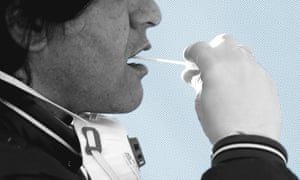'Typical' COVID Presentation Symptom Giveaways
"We know that when patients with psychiatric diseases get sick, it kinds of mentally de-compensates. And we realized that the reason that her [emergency room patient] schizophrenia reaactivated was because of COVID-19.""A few hours later she spiked a fever and then we realized, 'Oh gosh, there's more to this story than just atrial fibrillation.""Theoretically, you know that this going on. And it's something we've been talking about. But to actually see that happen right in front of me was like, 'Oh my God'.""I was fortunate that I had taken appropriate precautions with her. I was wearing a mask, I was wearing a gown. But I was just kind of going through the motions, just doing it because everybody else was doing it.""And then when she spiked a fever, it really became much more internalized."Dr.Gregg Miller, emergency room physician, Seattle"We're just seeing so many strange presentations of this that basically we're in a state where almost anybody coming in with anything is a potential COVID case.""We're taking precautions with everybody now. We're treating every single patient as a potential COVID patient.""What's become very frightening is that, initially we had this very clear case diagnosis. It was travel and a cough and shortness of breath and fever.""But what we've been finding is almost anything can be a presentation of COVID-19.""We've seen patients whose only presenting symptom is headache or their only presenting symptom is abdominal pain and we swab them and they're positive."Dr.Brett Belchetz, emergency medicine, Toronto
 |
Covert cases could represent around 60% of coronavirus infections.
Image: REUTERS/Toby Melville
|
In his Montreal hospital emergency department, Dr.Zachary Levine by early this week had seen about 20 presumptive cases of COVID-19. then, a 37-year-old woman had come in. She qualified for testing because she had minor chills. But she had also suffered weeks of bloating and abdominal pain; those would never have qualified her for testing, without the presence of the chills of a minor nature. But you never can tell, and when her test came back, it told that she was indeed COVID-positive.
Most others he had seen had exhibited classic symptoms, and then there was another case that failed initially to qualify for testing, a women in her 70s who had recently returned from a trip to the Caribbean, with fatigue and malaise. No fever, no cough. "Luckily I wore a mask/visor/gown and gloves out of an abundance of caution", said Dr.Levine. An X-ray revealed chest abnormality, so he sent her for COVID testing; yet another positive.
 |
In Dr.Miller's experience, a psychiatric patient entered the Emergency Room, delusional, hearing voices, she had a history of schizophrenia. She was asked to wait for a psych bed to become available. She waited a full day. This was a major hospital outside Seattle, in a busy ER, not unusual for specialized treatment. Then her fever spiked, alerting medical staff that something more than mental illness had presented.
Emergency Rooms and Intensive Care Units in hospitals across Canada and the United States have been separated; patients suspected or diagnosed with COVID-19 plugged into one side; those with no symptoms on the other. Then doctors increasingly realized the difficulties they were experiencing in ruling out anyone as a possible carrier of the COVID virus.
Trying to cope with an emergency in the pandemic, with the tension-filled expectation of sudden surges, hospitals have been faced with limited protective equipment along with backlogs for testing, exacerbating an already vexing situation. Dr.Belchetz was informed by one of his colleagues of a patient who arrived with a head laceration. "Everyone assumed it was nothing to worry about". Head wound? ERs are well accustomed to dealing with them.
 |
But in this particular instance after questioning the patient, it was revealed how the wound had occurred. The man had passed out and then had fallen, hitting his head on a hard surface, and sustaining the wound. There were no typical symptoms at presentation; no cough, no fever, but it was clear he wasn't getting enough oxygen. When the test came back, it revealed that he too, had COVID-19.
Despite all of this, Dr.Miller failed to fully realize the extent of the situation of unusual, atypical presentations, but when in the early weeks of the pandemic a woman came to his ER with an erratic heartbeat and a history of atrial fibrillation -- with her heart wildly beating at close to twice normal rate, he and his colleagues focused on that; getting her heart rate under control. Before realizing she was another COVID patient.
Recently, Dr.Miller along with a few colleagues published a paper on early lessons from the pandemic in the Seattle area. The message, he said, is not that it's useless to separate COVID from non-COVID. "You can do it, you just can't assume that because you've done that, the rest of your ER or your clinic is COVID-free". The virus is both sinister and insidiously diagnosis-tricky.

Labels: Atypical, Contagion, Diagnoses, Emergency Room Admissions, Novel Coronavirus, Syptoms
0 Comments:
Post a Comment
<< Home